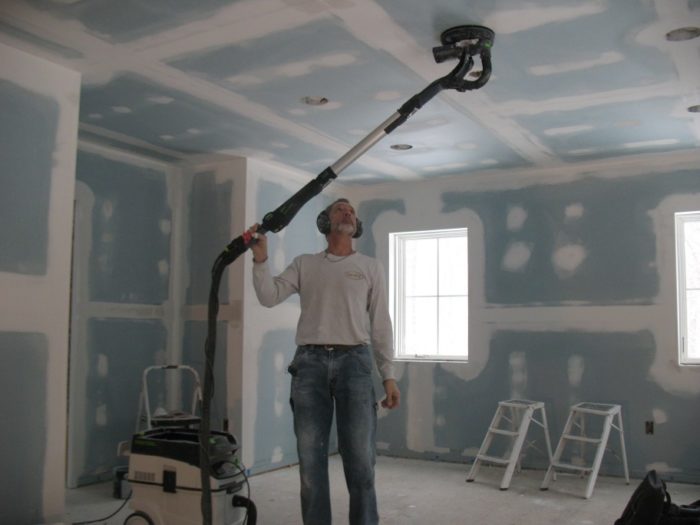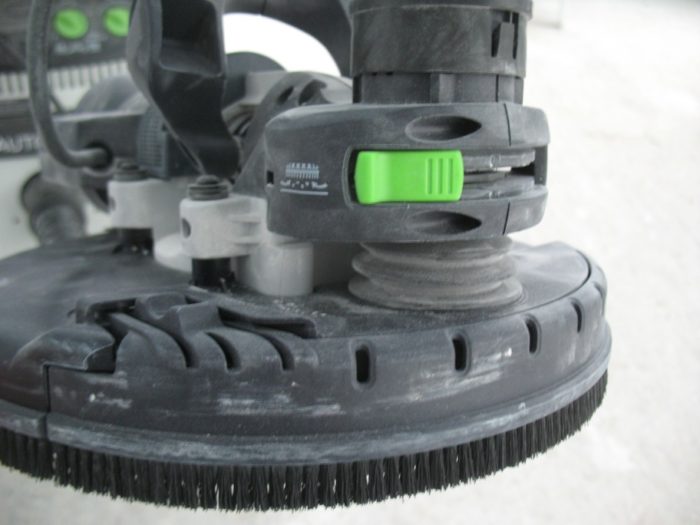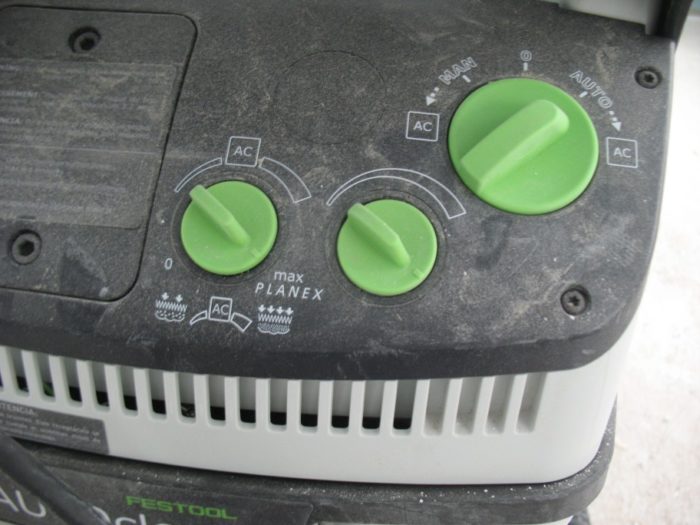Anti-Gravity Drywall Sander and Dust-Collection System
Festool Planex Drywall Sanding system works like an automatic pool cleaner—almost.
If I could design the perfect drywall sander, it would work like an automatic pool cleaner. Hook up the suction line, then sit in a lounge chair watching the device crawl around cleaning the pool surfaces—or, in the case of drywall, turn on the sander and watch it sand the walls and ceilings without any dust. Until someone develops a fully automatic drywall sander, Festool’s Planex is the next-best tool.
The Planex is a drywall sanding system – powerhead, sanding abrasive disks, sectioned handle lengths and dust collection. With multiple controls for sander rotation speed and suction along with abrasive grit choices you can fine tune how aggressive (or not) you want the Planex to attack the compound. The only thing you have to do is guide the sander around.

I have a few dust-extraction-type drywall sanders, both manual and orbital. Some are homemade devices made from 5-in. orbital sanders and others are manufactured models. Each one has been an upgrade in ease of sanding and dust collection. I think, though, that they’ll now all be set aside with the Planex on the job site.
The most noticeable design element on the Planex is the motor position. Instead of a flexible drive shaft with the motor at the handle end of the tool the Planex has the motor at the power head. This makes the tool head-heavy until you hook a dust extractor to it and place the head against a surface. Planex uses the vacuum suction to hold the head to the drywall surface. It’s like an anti-gravity system that counteracts the mass of the power head. You can micro-adjust the suction from weak to strong to both hold the head to the ceiling or wall surface and manage how aggressively the sander cuts the compound. The greater the suction, the stronger the suction bond, and the more aggressive the sanding disk will cut. The strength of suction does impact how freely the head glides over the surface. The more suction—more friction—the more effort to move the head. There’s a learning curve to make the adjustments work just the way you like. After tweaking the suction several times, I found I preferred less suction when sanding ceilings and more suction working on walls.
The Planex is virtually dust-free. The power-head brush cowl contains the sanding dust and the vacuum suction carries it away. The vacuum stream for dust collection is separate from the suction-bond vacuum stream. The dusty air travels through the cowl while the suction bond and additional air travels through the 8-hole sanding disk. At the end of sanding the first floor, I weighed the sack of duct in the extractor: 14 lb. After I vacuumed the dust on the floor and it weighed less than 8 oz (and some of that was the hand sanding I did after compound touch-up sanding and detailing the inside edges of the drywall window returns).
 A slide switch on the power head macro-adjusts the suction bond between the head and the drywall surface A slide switch on the power head macro-adjusts the suction bond between the head and the drywall surface |
 Slide the switch to the right for maximum suction bond. Slide the switch to the right for maximum suction bond. |
There’s a slide switch on the power head that controls how much vacuum suction the head has to hold it to a surface. Even when the bond suction adjustment is turned down, the dust extraction suction continues to work.
There’s also a suction control on the side of the handle so you can tweak how the tightness of the head-to-surface bond while operating. And just above the power switch is a speed-control wheel that adjusts the disk rotation between about 300 rpm to 900 rpm. Once you dial-in a setting, the motor will maintain a rotation speed even when the abrasive bogs down on a high spot.

The sander motor has a soft start so the abrasive doesn’t dig in and cause the head to jump. You can position the head, flip the switch, and ease into sanding without a jolt.
The sander disk is about 9 in. diameter, so you can cover a wide area with each pass. The hook and loop type abrasive disks stay put even when sanding aggressively. The Festool abrasives are long-lasting. I sanded off the first-floor (900-plus sq. ft.) walls and ceilings with one 220 Granat disk. And it would have lasted much longer, but I hit the edge of a steel box and ripped the disk edge. The slight swirl pattern left by the finer (220) sanding disks disappeared under a standard drywall primer, so there’s no need for hand sanding to take out the rings. And don’t worry about paying through the nose for Festool sanding disks—a 25-pack of Granat disks lists for only $38. I figure we’ll only use 3 or 4 disks ($5 to $6) sanding the drywall on the whole 2700-plus-sq.-ft. house.
Getting tight into corners is made easier by removing a brush segment off the power head. When the section is removed, the edge of the sanding disk gets right up to the corner without gouging the opposite side. I turned down the sanding speed and most of the dust was still collected despite the brush being removed.

There are two standard configurations with the three parts in the Planex kit. The sanding head can be connected directly to the control-handle section with an overall length of about 43 in.—good for tight spaces or working closely on walls. Including the standard extension section and using all three pieces totals about 64 in. long. Additional 20-in. long extension sections are available for taller ceilings (10 ft. to 12 ft.).
When working on tall ceilings, you may want to get the sander support-harness accessory kit. It has a slide-adjusting bar that clamps to the Planex handle and extension and rests in the waist pocket of a body harness. I tried using it on our 8-ft. 3-in. ceilings, but it wasn’t helpful since I’m 6 ft. tall. If I were shorter or the ceilings were taller, the support system would have reduced the fatigue of holding and guiding the Planex over ceiling surfaces.
 |
 |
OK—so what’s the cost? The Planex kit lists for $1,150—more than double the cost for other 9-in. drywall sanders. But the Planex is worth the cost for my business. I do a lot of my own drywall hanging and finishing on small to medium remodeling jobs where superior dust control is critical. And I now my brother and a couple of trusted friends will borrow the Planex for their projects, so it will be put to good use.

The sander is only half the system—the other half is the CT 36 AutoClean Dust Extractor, which lists for $850. It can be used for dust extraction with other tools and as a vacuum so you don’t need other vacuums on the job.
Fine Homebuilding Recommended Products
Fine Homebuilding receives a commission for items purchased through links on this site, including Amazon Associates and other affiliate advertising programs.
Paslode Cordless Finish Nailer (IM250A)
Milwaukee Cordless Shop Vac (0880-20)
DEWALT Impact Driver (DCF885)



